“Marine stratocumulus clouds play a very important role in the speed that climate change is taking place and sea surface temperature has a big effect on how many of these clouds there are,” said Roebeling.
“When these clouds disappear, the ocean is exposed to more sunlight and gets warmer. Then the likelihood that the clouds will come back is even less, because the process becomes almost irreversible as the temperature difference between the sea surface and the air diminishes.”
By using data from Metop and Meteosat satellites, as well as from the United States National Oceanic and Atmospheric Administration (NOAA) satellites, the team confirmed that sea surface temperature across the globe has increased between 1982 and 2018. They then assessed the effect of a change in sea surface temperature on cloud cover for the same period of time and found that for each degree Celsius of ocean warming, marine stratocumulus cloud cover in some regions may have decreased by more than 2%.
As marine stratocumulus clouds continue to diminish due to increasing sea surface temperature as well other factors, such as decreasing sulfur emissions from shipping, it is essential to continue to monitor these clouds using satellite instruments.
“New instruments on EUMETSAT’s next-generation satellites are incredibly helpful in providing more and better data,” said Roebeling. “The measurements from these new missions are higher resolution and more precise, making it possible to better quantify phenomena such as marine stratocumulus cloud cover, and be able to more precisely identify where changes are occurring.
“As older satellites have reached the end of their lifetimes, it is important that new satellites replace them. This way, we continue to build an uninterrupted time series of measurements.
“This is why instruments such as the Sea and Land Surface Temperature Radiometer on the Copernicus Sentinel-3 satellites as well as new instruments on EUMETSAT’s next-generation satellites such as METimage on Metop Second Generation A are so essential – to monitor the climate, we need reliable, precise measurements over a long time span.”
Roebeling hopes data from these satellites will ultimately empower policy makers and others to implement meaningful strategies to diminish global warming.
"It is important to keep monitoring climate change and to track changes as accurately as possible,” he said. “Only then can we diagnose the problems and take action.”
Author:
Sarah Puschmann



